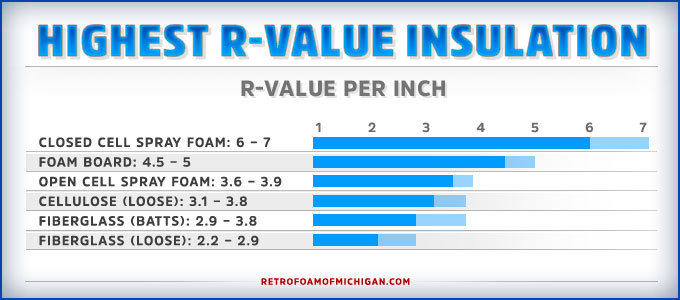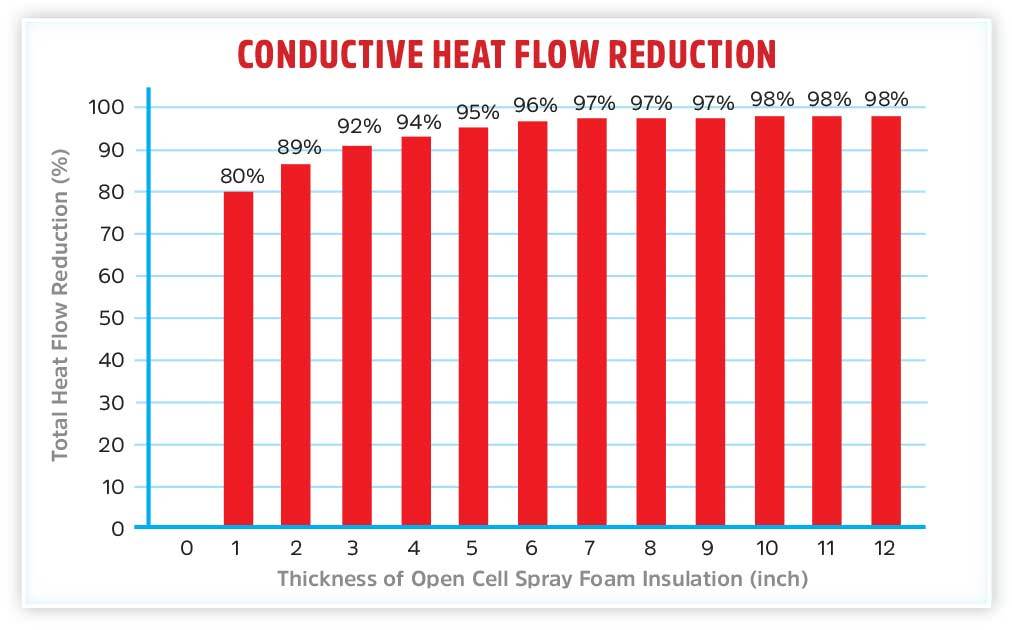What is the Highest R-Value Insulation? (Ratings/Types/Charts)


Why does researching home insulation have to be so complicated?
Why are there so many numbers? What do they mean? Is a higher R-Value better or is there something that supersedes that measurement? Are there outside elements that can change an insulation’s R-Value?
Those are a lot of questions and they are all ones I have asked myself as the content manager here at RetroFoam of Michigan. Luckily I have picked the brain of our Professor of Foam and scoured the Internet so I can finally and definitively answer what is the highest R-Value insulation, what impacts insulation R-Value, and is a higher R-Value really better?
So, let's jump right into this educational journey together.
What is Insulation R-Value?
R-Value is the measurement of an insulation material’s thermal resistance.
In layman’s terms, it measures an insulation’s ability to resist heat transfer through contact, or conduction.
Have you ever sat on a cold bench and had the air sucked right out of your lungs from the shock? Eventually, your body heat warms the spot where you are sitting as you get colder as well. This is heat loss through conduction in a nutshell.
Insulation R-Value means the thicker the insulation, the more efficiently it reduces heat loss.
Insulation R-Value Chart

As you can see above, each of the materials represented has different R-Values.
Here’s a little closer look at that range for each material per inch. Keep in mind, that there is a range because different brands may have a different R-Value. The same is true for different manufacturers and products.
- Closed Cell Spray Foam: R-6 to R-7
- Foam Board: R-4.5 to R-5
- RetroFoam Injection Foam: R-4.6 to R-5
- Open Cell Spray Foam: R-3.6 to R-3.9
- Cellulose (Loose-Fill): R-3.1 to R-3.8
- Fiberglass (Batts): R-2.9 to R3.8
- Fiberglass (Loose-Fill): R-2.2 to R-2.9
How Much of the Highest R-Value Insulation Do I Need?
Now at a glance, the insulation ratings above could be a little confusing, so keep in mind those are the per inch R-Values.
The amount of insulation you need is determined by the climate zone you live in. A colder state will require a higher R-Value and a state that tends to be warmer won’t need as much insulation.
The U.S. Department of Energy uses an uninsulated attic as an example and it is a great place to start.
States like Florida and parts of Texas would only require an R-30 to R-49 in an uninsulated attic. States that tend to be colder like Michigan or Wisconsin would need between R-49 to R-60 or higher.
Now that you know what’s required, you’re probably wondering how you get there, and this is really when the highest R-Value insulation conversation begins.
Traditional insulations, like fiberglass and cellulose, can achieve a higher R-Value because you can essentially double and triple up the material and composition to hit the numbers you need.
When you’re talking about injection foam and spray foam, it’s not that simple and I am going to thoroughly explain that in just a moment. On the surface, you would think the recommended 6- to 10-inches of open cell spray foam depending on where you live or 5-inches of closed cell spray foam on the roof deck is only going to give you an R-Value of around R-21 or R-30 respectively, making spray foam appear to have lower insulation ratings when it comes to R-Value.
Before we do that deep dive into whether the highest R-Value means the best insulation, let’s talk about some factors that impact insulation R-Value.
What Impacts Insulation R-Value?
R-Value isn’t set in stone, meaning there are things that can impact that number not only lowering it but essentially making your insulation ineffective.
When you add insulation, you don’t expect cold temperatures to cause it to lose R-Value, but that is exactly what happens to fiberglass. Studies have found that as the temperature dips below 32 degrees, fiberglass begins to lose R-Value. As the temperature continues to drop, so does the R-Value which can be a real problem when it comes to energy efficiency and comfort.
A side note for RetroFoam injection foam insulation, when the temperature goes down, the R-Value will actually go up from R-4.6 per inch to R-5 per inch.
Another thing that can lower the R-Value of fiberglass, as well as cellulose is if either of the materials gets wet. Both materials retain that moisture, which not only lowers the ability to insulate but also leads to the growth of mold.
How fiberglass, cellulose, foam board, or even foam is installed can also impact their individual R-Values. This is because if the material is installed improperly, you’re still allowing for heat loss through convection, which is air movement.
If there are gaps with no coverage or the material doesn’t fit perfectly and evenly where it is installed, then a space has been created for air movement. These gaps can also be created in traditional insulation materials over time as both fiberglass and cellulose are known to shift, settle, and sag as time goes on.
Even if properly installed cellulose and fiberglass are prone to airflow, which means that cold or hot air you’re trying to keep out of your home can still move through both materials. There is one insulation option though that eliminates that air movement.
Does Highest R-Value Mean the Best Insulation?
Do higher R-Values mean the material you’re considering is the best option for your home?
Absolutely not, and here’s why.
There is more to consider when buying new insulation and it comes down to R-Value versus creating an air seal.
Sure, code might call for R-49 in your attic and spray foam doesn’t hit that number at recommended depths. But what it can do, whether it’s open cell or closed cell, is create an air seal.
Foam is the only insulation option that creates that air seal, but now you’re probably wondering about code and that’s good.
You see, you don’t want to try and double and triple the amount of foam you install because you only need about 2-inches of closed cell or 3-inches of open cell depending on the product to create that air seal. I know what you’re thinking, and yes, I said we recommend more than this on the attic roof deck, but that’s to also create a stronger thermal barrier. Heat rises and you want to make sure that the thermal barrier is in place even with the air seal.
Piling on inches of spray foam is a waste of money as it diminishes your return. Once you create the air seal, you won’t have any more return on investment by adding more foam. This chart does a better job showing this than I can explain it.

The next thing you’re likely thinking is about that insulation code.
The thing is injection foam and spray foam can pass code without hitting those R-Value numbers and it all comes down to how it performs. Inspectors don’t take the foam insulation contractor's word for it, but they do take the word science.
The insulation contractor has to prove to the inspector that the foam’s performance creates an air seal, has an aged R-Value, and several other variables. Proving all of this is done by taking all of the insulation data, room assemblies, etc., and putting them into a program like REScheck or HERS Index.
Both of these programs test the performance based on the data provided and give a pass or fail that the contractor can then give to the inspector.
Best Insulation R-Value and Ratings
So, when it comes down to it R-Value is important if you plan to use materials like fiberglass, foam board, or cellulose, but if you’re looking to create an air seal, then those numbers don’t mean as much.
The best and most efficient insulation may not in fact have the highest R-Value per inch or per wall cavity. In this case, it comes down again to what the material can do and how it performs.
Foam insulation has a lot of benefits aside from creating that air seal, and if you’d like to learn all about the, check out the Learning Center on our website.
Related Articles
What is R-Value (Definition/Meaning/Importance)
What is the R-Value of Spray Foam Insulation?
R-Value vs Air Seal: What is More Important When Buying New Insulation?
About Amanda Emery
Amanda previously has worked as a breaking news and crime reporter, TV news producer, and editor in Flint and Detroit. Throughout her career as a journalist, she has won several awards from The Society of Professional Journalists - Detroit Chapter and the Michigan Press Association. As part of the RetroFoam of Michigan family, Amanda uses her experience as a journalist to write content that will help educate homeowners on the benefits of foam insulation. When Amanda isn’t writing, she’s spending time with her husband and rescued huskies. She also loves knitting, making art, cooking, and hosting dinner and a movie night for friends and family.


